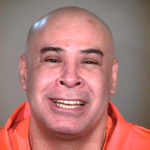
The Arizona Department of Corrections executed Samuel Villegas Lopez June 27, three days before his 50th birthday, for the brutal rape and murder of Estafana Holmes in 1986.

Lopez stabbed the 59-year-old Holmes 29 times in her left breast and upper chest, three times in her lower abdomen, and cut her throat.
The night before his execution, more than 70 people gathered on the Capitol lawn to pray for his soul and the end of the death penalty.
“The Church position is that we need to defend all human life, from the moment of conception until natural death,” said Auxiliary Bishop Eduardo A. Nevares, who joined those gathered. “This would include the elderly, the physically and mentally challenged and criminals.”
In the Gospels, Christ calls Catholics to “love our enemies,” he said in an interview with The Catholic Sun. “Jesus Christ reminds us of the Ten Commandments, but teaches that they are all summed up in the two Great Commandments: ‘Love God above all things, and love your neighbor as yourself.’”

Christ also called his followers to forgive “70 times seven times.”
“We need to apply these and other teachings of Jesus Christ in our dealings with all: the criminal, the victim and with [the] perpetrator,” the bishop said. “Acquiring vengeance, especially for a very horrible, indefensible, inhuman crime does not lead to one’s peace of soul, but only to one more act of violence.”
Mike Phelan, director of the diocesan Marriage and Respect Life Office, also joined those gathered.
“The fact that we’re doing this so regularly in Arizona is not a good sign,” he said. “It was a heinous crime. But the question we have to ask ourselves is does executing a person contribute to the culture of life or to the culture of death?”
Joe Canarie and group of young people from André House also joined the vigil.
“The Gospel is screamingly clear that we are called to forgive unceasingly and to a life of non-violence,” Canarie said. “The death penalty is inconsistent with our faith.”
Catholics should educate “our brothers and sisters in the faith” about Church teaching against the death penalty, he said.

Dan Peitzmeyer of the Arizona Death Penalty Forum noted that Lopez had no education as one of 13 children. It is believed that he was conceived by rape, was tortured as child and grew up largely on the streets. When he was 9, Lopez began sniffing paint, which has lasting detrimental effects on the brain.
“It was a horrible murder, vicious, violent enough to turn your stomach,” Peitzmeyer said, having sat through the five and a half hour clemency hearing.
“We could have been kinder to the family members if we didn’t drag them through all of this,” he said. “Society is not safer because this man is dead.”
The vigil wasn’t to defend the actions of murderers on death row, Peitzmeyer said. Holmes’ blood was spattered throughout her apartment. Lopez crammed a scarf tightly into her mouth, and her body was found half naked.
“The murder committed is atrocious, but I didn’t do it,” Peitzmeyer said. “When the state does it, then the blood is on my hands.”






